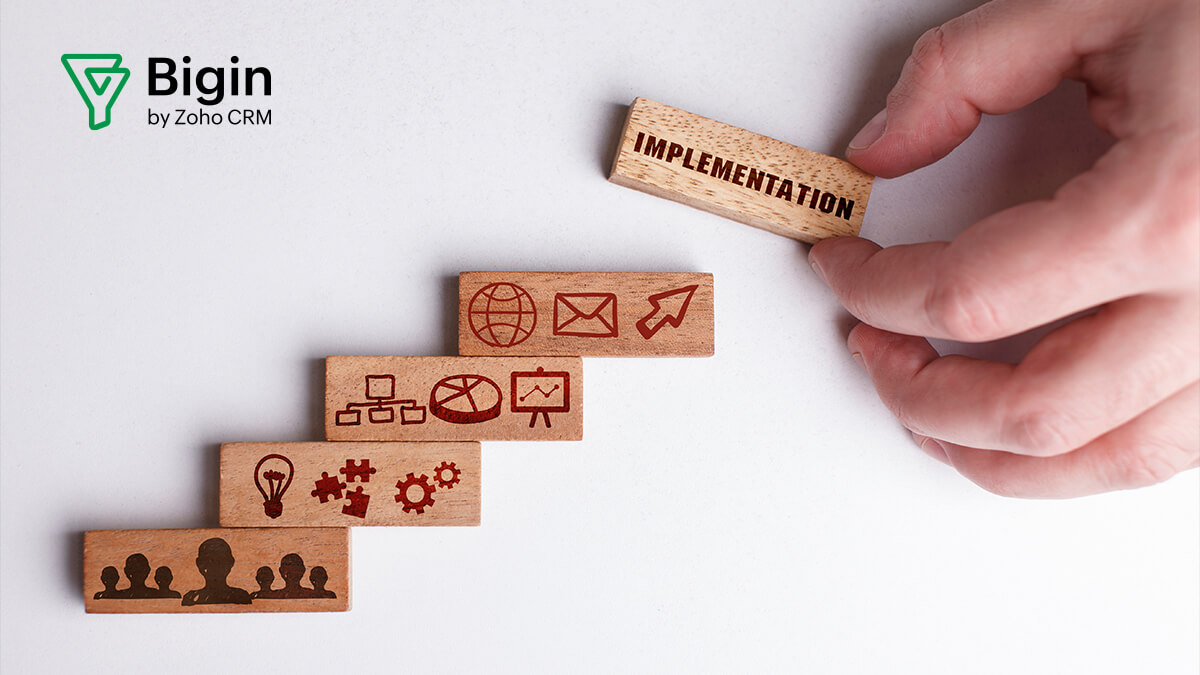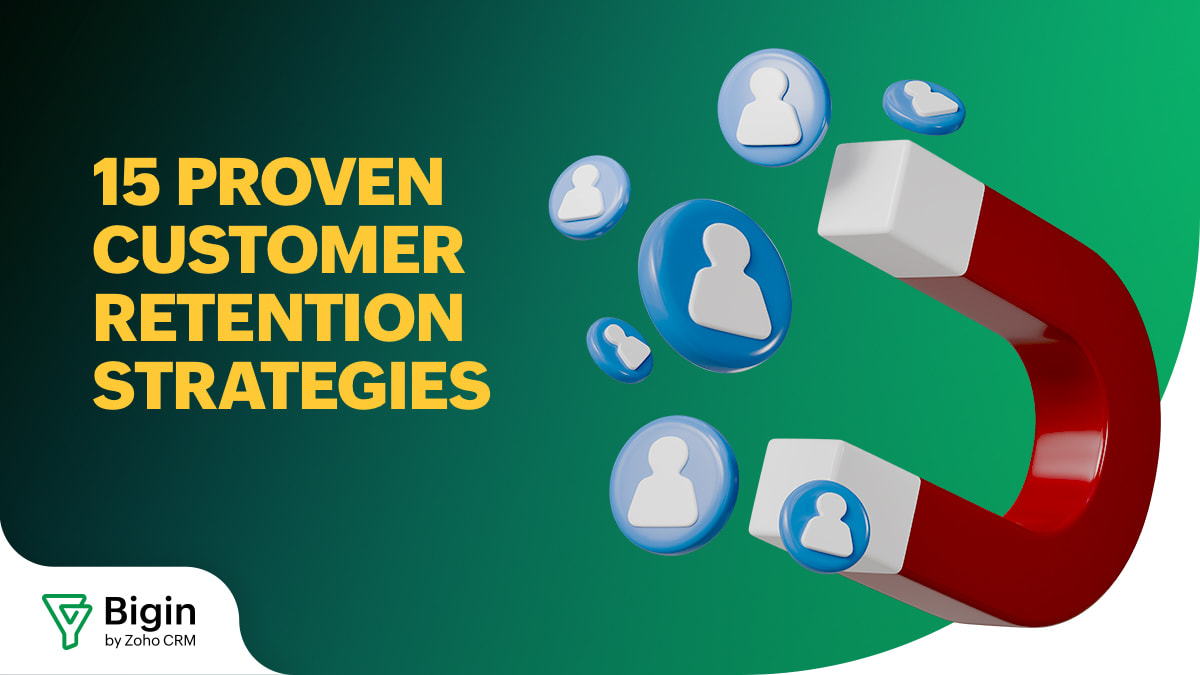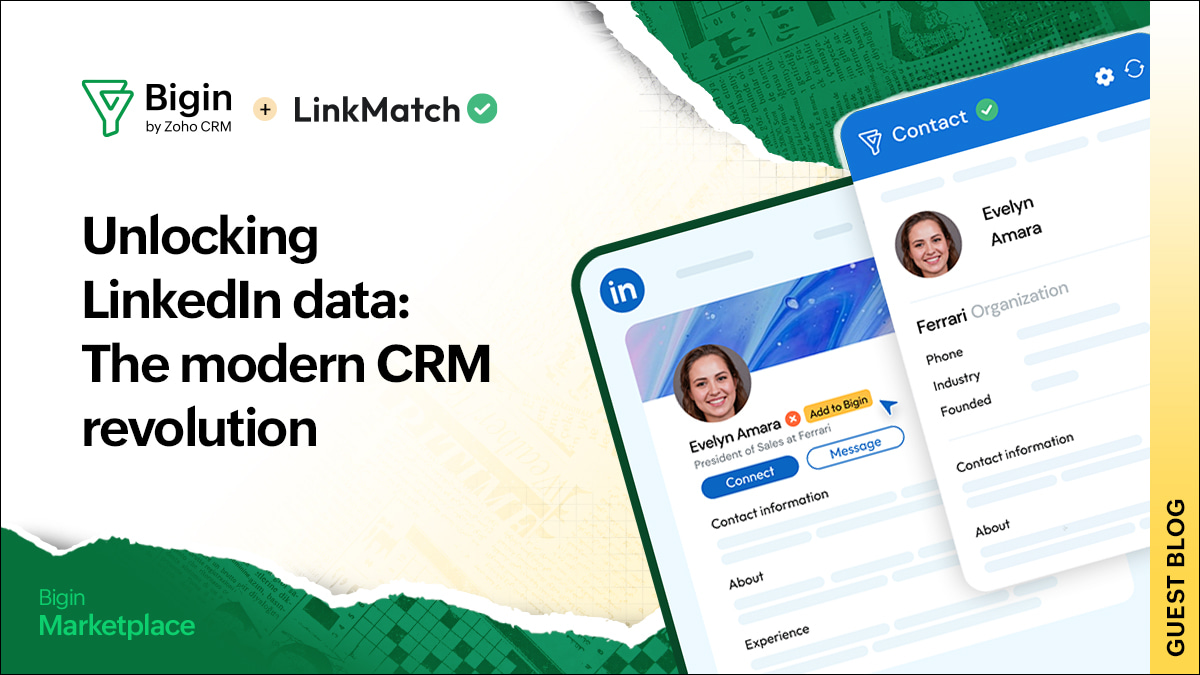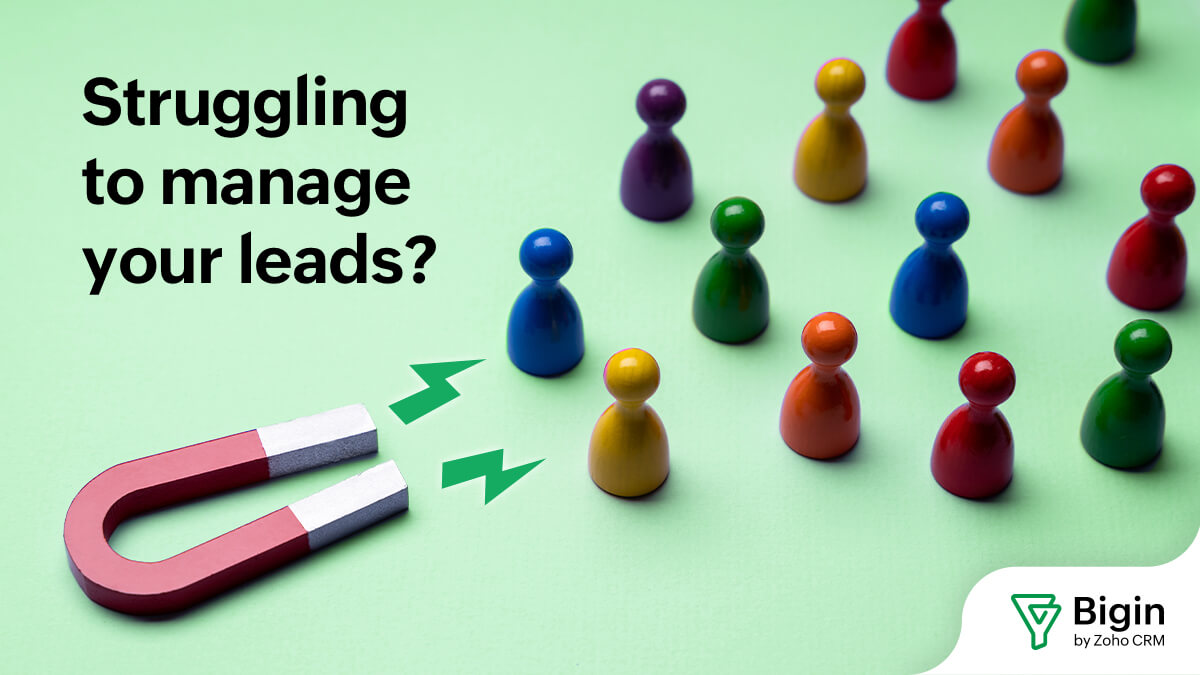How long it takes to implement a CRM: A step-by-step guide
- Published : July 16, 2024
- Last Updated : September 30, 2024
- 806 Views
- 10 Min Read

If you're reading this, you've probably already decided that it's time to transition your business to a customer relationship management (CRM) software tool. Bravo on this excellent decision. In good time, the benefits you stand to gain from this transition are immense.
Not only will you have all your customer data available in one centralized, user-friendly platform, but you'll also be able to leverage various modern sales and marketing automation features that will enhance the customer experience. If you haven't made your mind on switching to a CRM, we did an in-depth article on why it's beneficial for teams to migrate from spreadsheets to a CRM. Do take a look when time permits!
Now, let's address why most of you're here today. You've probably narrowed down your choices to a few popular CRMs and are wondering which one to pick. And you might also be wondering how long it takes to implement a CRM.
That's why we've broken down the various factors and steps to keep in mind while assessing the potential timeline for implementing a CRM.
Here's what you'll learn from this article:
Insights into factors influencing the implementation timeline
A step-by-step guide to implementing your CRM
How to set realistic expectations and plan accordingly
While we can't provide an exact timeframe, this article will equip you with the knowledge you need to navigate your CRM implementation process effectively.
Factors affecting CRM implementation time
Business size
The size of your business is a good indicator of the time frame you might need to implement your CRM.
Remember that it's far easier for a small business to set up a CRM as opposed to, say, a medium to large enterprise. There are fewer sales reps that need ramping up, fewer customers to visualize on the dashboard, fewer workflows to set up, and fewer customizations in play.
Smaller businesses typically have simpler operations, a lower volume of data, and a smaller workforce that can be trained and onboarded onto the new CRM system easily.
External stakeholders involved
The number of external parties a business owner needs to deal with also plays an important role in CRM implementation time. Generally, the more external stakeholders involved, the longer the CRM implementation process takes.
For example, a company may need to consider how it will manage relationships with multiple vendors, distributors, or partners within the CRM system. This often requires additional customization and integration work, which can extend the implementation timeline.
Conversely, businesses with fewer external stakeholders can typically implement a CRM more quickly. They can focus on core functionalities without needing to account for complex external relationships or data flows.
The key is to identify all relevant stakeholders early in the planning process and consider how they'll fit into your CRM strategy.
CRM implementation quadrant: A starting point.
The graphic below provides a general framework for estimating the time needed to implement a CRM system, considering two key factors: the business's size and the level of external stakeholder involvement.
Small businesses with few external stakeholders can often implement a CRM in a matter of weeks or a few months, with fewer complexities and fewer parties involved.
On the other hand, medium to large businesses with significant external stakeholder involvement are likely to fall in the "time-consuming CRM implementation" quadrant.
These organizations typically have more intricate processes, larger teams, and multiple external parties (vendors, consultants, partners) to coordinate. As a result, the implementation timeline could stretch from several months to a year or more.

Remember, this graph provides a broad generalization. The actual timeline for your CRM implementation will depend on various specific factors unique to your business. This framework can serve as a helpful starting point to gauge the potential scope and duration of the project.
Once you determine which quadrant best represents your organization, you can then assess how other factors might influence the timeline, which may shift your estimate to a different quadrant.
Remember to exercise informed judgment based on your understanding of your business's needs, processes, and resources.
Customization and configuration needs
What you sell matters, as it determines your customization needs. Businesses that involve complex workflows, multiple sales touchpoints, and customized outreach will require time and effort to set up a CRM. For example, consider a small consulting firm that helps companies implement enterprise software.
Despite its size, this firm may have complex sales processes involving various stages like lead evaluation, proposal creation, contract negotiations, and project planning. Their sales cycle might also be lengthy.
To accommodate these nuances in the CRM, the firm might need to create custom fields, configure tailored views, set up automated task reminders, and integrate the CRM with project management tools.
In contrast, a small ecommerce business selling physical products may have a more straightforward sales process, with fewer customer touchpoints and more of a transactional nature. In such cases, the CRM implementation could be more streamlined, focusing primarily on capturing customer information, tracking orders, and integrating with the ecommerce platform.
Team competency
The level of competency within your team will also play a crucial role. Employees with prior CRM experience can significantly speed up adoption across the organization. Because these individuals are already trained on a CRM, their experience thereby reduces the amount of training you need to provide them.
If you have employees without any CRM experience, the time it takes to train them and get them accustomed to using a CRM will increase your overall CRM implementation timeline.
Implementation approach: On-premise or cloud-based
The approach you choose for implementing your CRM system can significantly impact the overall timeline. There are two main options: on-premise and cloud-based implementations.
On-premise implementation
Organizations that install and run on-premise CRM solutions do so on their own servers and infrastructure. This approach requires more upfront resources for hardware, installation, and configuration.
It also demands time for IT setup, data migration, and system integrations. Due to the complexities of internally managing hardware, software, and IT resources, on-premises implementations often take longer to complete compared to other options.
Cloud-based implementation
Alternatively, you can use the services of vendors who host and maintain cloud-based CRM solutions, which eliminates the need for extensive on-site infrastructure. These solutions are typically faster to implement as they require less upfront setup and configuration on your end.
The vendor handles most of the technical aspects, such as software updates, backups, and security. However, you'll still need to allocate time for data migration, integration with other cloud applications, and user training.
So what do the studies say?
Aptitude 8, a CRM implementation consultancy, surveyed sales and marketing professionals working in organizations with 100 to 1,000 employees and asked them many CRM implementation-related questions.
According to their findings, 43% of the sales and marketing professionals surveyed reported a CRM implementation process that took four months or longer. Granted, there was no insight into the nature of the businesses these professionals were working for, so you might want to take that figure with a pinch of salt.
But it should give you a decent idea of the potential timelines involved. The duration could vary significantly, ranging from as little as a month to as long as twelve months to implement a CRM successfully.
Next, we'll explore the implementation process in detail to help you better estimate your CRM timeline.
The CRM implementation process: A step-by-step guide
Implementing a CRM system can seem like a daunting task, especially for a small business. But with the right approach, it can be a smooth and rewarding process.
To illustrate this, let's walk through a hypothetical example of how a small business might implement a CRM system. As our example, let's use the fictional Sunny Side Bakery, a small, local bakery with 10 employees. This example will give you a clear picture of what to expect and how to navigate each stage of the process.
In our scenario, Sarah, the owner of Sunny Side Bakery, realizes she needs a better way to manage customer relationships and grow her business. She decides to implement a CRM system to help streamline operations and improve customer service.
Let's explore how Sarah and her team might tackle the CRM implementation process.
Step 1: Needs assessment and planning
Sarah gathers her team for a brainstorming session. They discuss their current challenges, like forgetting regular customers' favorite orders and missing opportunities to remind people about special occasions. They realize a CRM could help them keep track of customer preferences and automate birthday reminders.
After identifying their needs, Sarah and her team set clear goals for the CRM implementation. They want to increase repeat customers by 20% in the first six months and boost overall sales by 15% within a year.
They also decide that Tom, the assistant manager, will lead the CRM project, with Sarah overseeing the process.
Step 2: CRM selection and evaluation
Sarah and Tom research CRM options that cater to small businesses. They make a list of must-have features, including easy order tracking, customer preference notes, and a simple loyalty program. They also consider their budget and the need for a user-friendly interface that won't overwhelm their less tech-savvy staff.
After narrowing down their choices, they request demos from three CRM providers. The whole team gets involved in testing these demos, providing feedback on which system feels most intuitive. They ultimately choose a CRM that offers a good balance of features, ease of use, and affordability, with room to grow.
Step 3: Data migration and integration
With the CRM chosen, it's time to gather all their customer data. Tom takes charge of organizing this data and creates a standardized format to enable a straightforward import into the new system.
The team spends a couple of days cleaning up the data. They remove duplicate entries, update outdated information, and ensure consistent formatting. This step is important because clean data is crucial for the CRM to be effective. Once the data is ready, they work with the CRM provider to import it into the new system safely.
Step 4: Customization and configuration
Sarah and Tom work closely with the CRM provider to tailor the system to Sunny Side Bakery's needs. They set up custom fields for tracking dietary restrictions, favorite cake flavors, and preferred pickup times. Also, to configure the loyalty program, they decide how many points customers earn per purchase and what rewards they can redeem.
Next, they set up automated workflows. For example, they create a trigger that sends a special offer to customers who haven't visited in over a month.
They also set up birthday reminder emails with a coupon for a free cupcake. Sarah sees these features as an exciting opportunity to offer personalized service without burdening her team with additional work.
Step 5: User training and adoption
With the CRM set up, it's time to get the team on board. Sarah schedules training sessions, breaking them into small groups to ensure everyone gets hands-on practice. The cashiers learn how to look up customer information and add new customers to the system. Sarah shows the bakers how to check upcoming orders and view customer preferences.
To encourage adoption, Sarah emphasizes how the CRM will make everyone's job easier. She shares success stories, like how the system helped them remember a regular customer's nut allergy and thereby prevent a potential issue.
Step 6: Testing and deployment
Before fully launching the CRM, Sarah, Tom, and a few trusted employees put it through its paces. They create test customer profiles, place fake orders, and try out all the features. They also test the system during a busy Saturday morning to see how it performs under pressure.
After ironing out a few minor issues, they're ready to go live. They choose a typically slower week to make the full switch, giving the team some breathing room to adjust. Sarah makes sure extra staff is on hand to help with any hiccups.
Step 7: Ongoing support and optimization
As the weeks go by, Sarah checks in regularly with her team to see how they're finding the new system. She encourages feedback and keeps a list of suggested improvements. When the cashiers mention that entering phone numbers is slowing them down, Sarah works with the CRM provider to set up a quicker input method.
Three months in, Sarah reviews the CRM's performance against their initial goals. She's pleased to see a 10% increase in repeat customers already. However, she notices they're not fully utilizing the email marketing features.
She arranges for additional training in this area, determined to make the most of their investment. With ongoing tweaks and support, Sunny Side Bakery continues to customize their CRM, turning it into a powerful tool for their business.
How long would a small business like Sunny Side Bakery take to implement a CRM?
For a small business like Sunny Side Bakery, we estimate the CRM implementation process to take about three months. With only 10 employees, decision-making should be quicker, and there are fewer external stakeholders to consider.
The team's varying tech skills might extend the training period. However, involving everyone in the selection process and focusing on thorough training could lead to smoother adoption, even if it takes a bit longer initially.
This timeline is just an estimate based on our example. Your actual CRM implementation could be shorter or longer, depending on your specific business needs and complexity.
Final thoughts
CRM implementation can boost your business operations and customer relationships. The Sunny Side Bakery example shows the importance of planning, resources, and team involvement.
While timelines vary based on your business, a strategic approach is key. Remember, CRM implementation is an ongoing process that should evolve with your business.
For small businesses looking to streamline their CRM implementation process, Bigin by Zoho CRM offers a tailored solution. Designed specifically for small and growing businesses, its user-friendly approach and focus on core functionalities make it an excellent choice for businesses wanting to experience the benefits of a CRM system without a lengthy or complex implementation process. Moreover, Bigin's affordable pricing structure ensures that businesses with limited budgets can access powerful CRM capabilities.
Start a free trial and experience the beauty of Bigin for yourself!
References
https://aptitude8.com/a-look-at-the-total-cost-of-ownership-of-hubspot-vs-salesforce
Read more from the author
It's time for sales teams to migrate from spreadsheets to a CRM
Churn in small businesses: Causes, early warnings and 13 strategies to reduce it
The transformative benefits of switching to a CRM tailored for small businesses
 Anubhav
AnubhavAnubhav is a product marketer with an insatiable thirst for all things content marketing, technology, and SaaS. His expertise lies in crafting compelling narratives that resonate with audiences and drive business growth. With a deep-rooted interest in entrepreneurship, Anubhav closely follows the latest industry trends and innovations, constantly seeking new ways to elevate marketing strategies.


